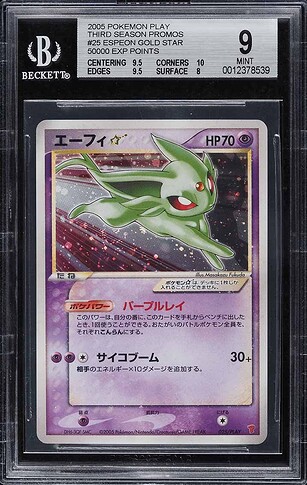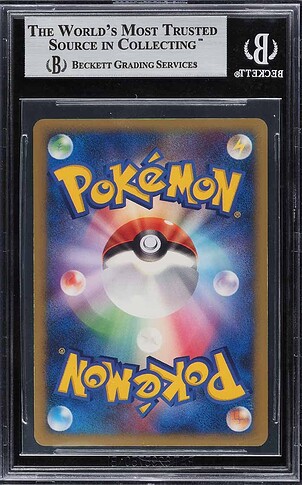It does, I nearly exclusively deal with vintage.
Judging from your eBay page id agree with almost all of those PSA grades. Perhaps they sorted themselves out from 95xx onwards. I’ve seen a lot of early 9x being quite lenient, especially with Japanese vintage.
I probably look at 100 ISH cards weekly and my observations are that 7-8x are on the whole very strictly graded, especially mid 7x.
Anyway, just buy the card I guess.
You can get a good essence of what is and isn’t fact even if you don’t submit a large amount of cards. There is enough data on eBay and other sales platforms.
Plus the owner of ludkins isn’t exactly a great data point. That ship went down VERY badly and I highly doubt he looked at cards personally.
Honest question: Do you genuinely think an average 2xxx cert vintage 10s would regrade to new cert PSA 10?
Same for a new card being submitted, I think it depends on the card. If you ask me if one of Gary’s PSA 10 Charizards would hit 10 again today, probably not. But you can say that for regrading some newly graded cards as well.
The problem in this discussion is selective strictness ≠ grading scale change. What CGC did when they started bumping 10’s was a grading scale change that applied to every card. What PSA is doing is selective strictness to higher end cards due to their liability. Their focus is to lower their rate of mis-grades for high value cards. Where in the case of CGC, they wholesale treated every card differently due to a full grade scale change. PSA is more quality control, where CGC was an actual scale change.
But how is that acceptable?
“Selective strictness for liability”
Aren’t you paying for an impartial opinion? This shouldn’t change. By this logic, 2xx certs should cross to a new cert and isn’t the liability part nulled buy their upcharges?
A card that deserves a 10 should get a 10, and one that doesn’t, shouldn’t.
Strictness Vs Grading scale, same thing different name.
This argument should honestly end at the fact you look at “100ish cards a week”. But sadly it won’t.
Those are your exact words. These are broad numbers, but PSA grades over 10,000,000 cards every year. You’re looking at ~.05% of the cards they grade, and are applying what you see of that .05% to 100% of what they grade. Hopefully this gives you some perspective.
Truly this should be the last comment (appreciation reply doesn’t count)
Yes, but what % are modern vs vintage? A very small % (yes, still a lot of individual cards).
I’m gonna make a thread of all misgraded PSA cards.
You guys will love it!
Every grading company sucks at times. Why do you care so much about a company that is barely relevant?
Mic drop below. This look like 9.5 edges to you?
laughs in raw
Without exaggeration, I look at ~10,000+ PSA graded cards per week and I have seen no repeatable patterns. And by the way, both of our sample sizes are too small to pick up on meaningful signals, even if they did exist, given the number of cards that PSA grades monthly.
Anyone with a basic understanding of actuarial science or loss prevention would know that high-risk, high-value assets (i.e., PSA 10 cards with massive premiums) should be treated carefully, as PSA is liable for compensating future buyers under the Grade Guarantee.
PSA (and all grading companies that offer a guarantee on their grade) has a financial incentive to be more stringent on higher-end cards. Whether this is “acceptable” from a consumer perspective is largely irrelevant, as they will always choose to cover their own ass before providing an unbiased opinion.
I only have a couple thoughts on this one here for what it’s worth. I think the cards that circulate on the marketplace that are PSA 10s are often not the best 10s as the collectors keep the best copies of these for themselves. That’s at least what I tend to do so it is easier to see the imperfections of those cards circulating.
I also don’t think that PSA 10s are meant to have 0 imperfections like a black label or other SUPER 10. I personally would love to own a black label but am more hesitant than ever with all the BGS craziness. Just my $0.02.
I recently received a CGC 4 I am adamant would achieve a PSA 9. Id have to find the card and post it on here.
Nobody has an issue with your opinions. The issue is you state them as FACTS when they are far from the truth.
I’ve said multiple times that they are my opinions.
Just to be clear here is my opinion on some of the above arguments
- Clean PSA 10s aren’t sold and only less quality cards are listed for same
- Most people grading volume are resellers. They don’t care about holding copies of cards. This argument is very out of date considering the time we are in. Plus, newer certs do tend to get a premium over older certs - so more reason to list for sale
This is a comment from a very large and reputable Pokémon business.
- You can’t get enough data from looking at slabs online that are available
- Yes you absolutely can make inferences from a sample size that is available to you. Studies do it all the time. It’s not possible to review every card ever, and you don’t need to in order to make assumptions.
All companies are equally good and bad. I am slab agnostic and own a lot of value in both bgs and PSA - it confuses me how some people here can so vigorously defend PSA without question.
@smpratte even said it himself, “PSA change strictness” when they see fit. It may not be a grading scale change per se, but that is clear enough that they are proactively changing what cards should get, when it suits them.
A 10 is a 10 and that shouldn’t change.
Thank you for listening to my TedTalk
I have a “different” view on it. Graded few hundred vintage reverse lately and found out 1 submission serious different in grades as the other 4.
Looks to me PSA might some better equipment who reveal any defect perhaps easier?
Also the grader still makes the difference, I am pretty sure about that.
I think you are misunderstanding Scott’s point. It’s not that PSA has changed their grading scales or arbitrarily imposed new conditional expectations . . . rather they put more time and scrutiny into higher value value cards due to their financial liability. The more time and attention a card receives, the more likely a grader is to notice its subtle flaws . . . especially when “over-grades” can cost the company money and cost a grader their job. The issue with PSA is not their consistency in grading scale (granted there is always a degree of subjectivity and variance in its application), but their consistency in time and scrutiny. In an ideal world, PSA should be inspecting every card as thoroughly as an Illustrator, but with the volume of cards PSA grades per day (most being low value), that’s not feasible, and there is no incentive to do so.
Flawed but Semi-Relevant Analogy
It’s like test driving a new car around the dealership vs. owning and driving the same vehicle for a year. You’re more likely to discover some nuanced issues (for example: window motor stutters/stops when it’s cold). That doesn’t mean your standards for “New” have changed; it just means you didn’t notice it without a more thorough inspection. I assume, most people in this situation would bring the car back to the dealership and have it repaired/replaced under warranty. This costs the dealership (or manufacturer time and money) which incentivizes better quality control. PSA is a large company, which has surely run careful cost-benefit analyses to determine how to balance low consumer prices, grading quality/consistency, and financial liability. Each of those levers can be adjusted, but not without some affect on the others.
I’ve said multiple times that they are my opinions.
You say this, but then also say stuff like this:
You can get a good essence of what is and isn’t fact even if you don’t submit a large amount of cards.
The reality is they change it all the time, they just don’t tell you.
Make it make sense
So you’re making assumptions off of looking at 100ish cards a week? Got it. Everyone should know this before continuing to engage.



